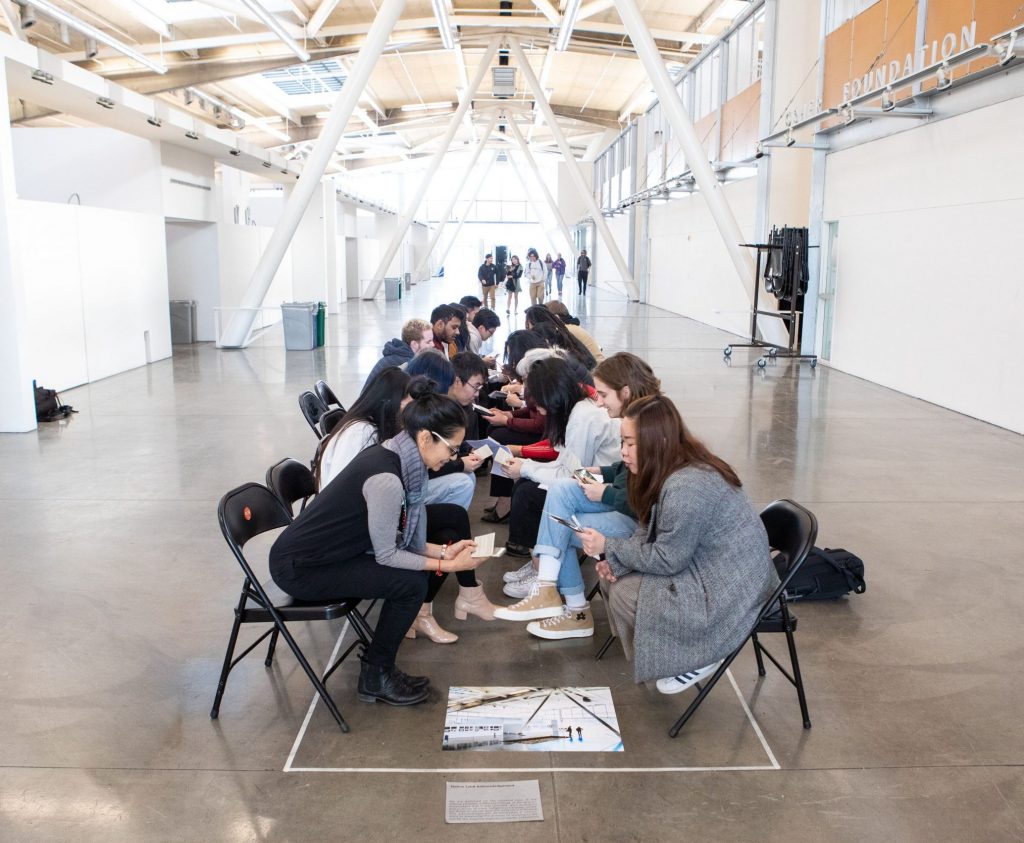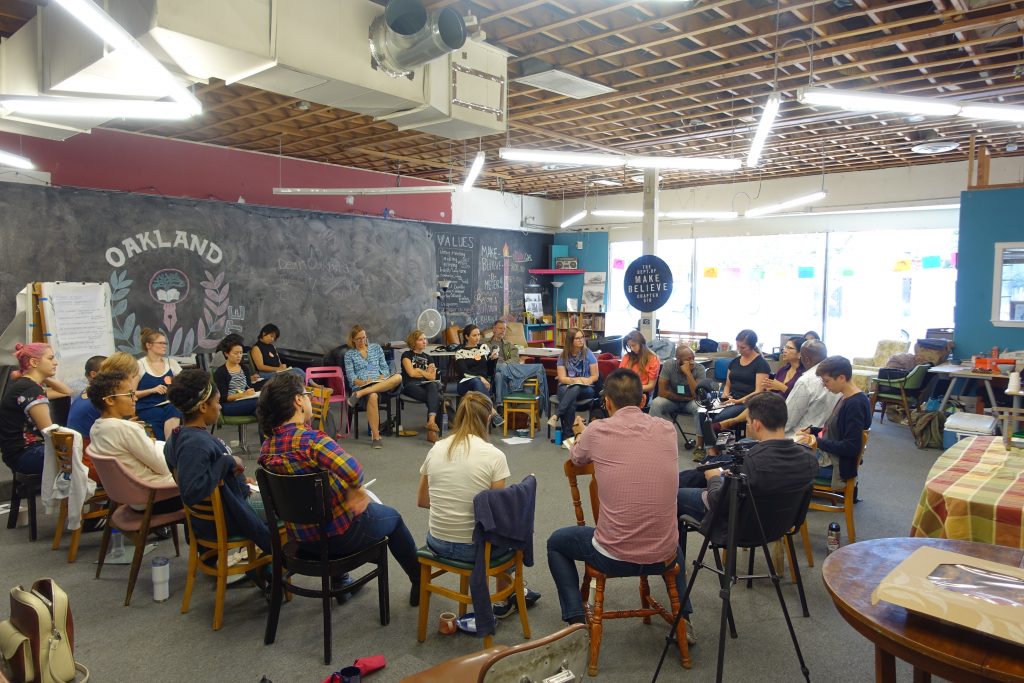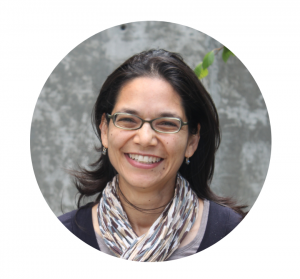Community Changemakers
Shalini Agrawal, Public Design for Equity
This conversation is part of our Community Changemaker Series. Build It Green is talking to people who are tackling climate change, addressing social inequity, and revitalizing communities through their work in the residential building sector. These innovators demonstrate what outcomes are possible when you think beyond a single problem and consider more multifaceted solutions. In highlighting these leaders and their work, we aim to spark ideas, drive discussions, and inspire others to engage and take action.
Background
We recently had the pleasure of speaking with Shalini Agrawal, Founder of Public Design for Equity, about her work as an interdisciplinary designer. After practicing as an architect for two decades, Shalini realized that the community-driven, inclusive design work she wanted to do wasn’t standard practice in her field. This drove her to found a Chicago non-profit called architreasures in 1996 and Public Design for Equity upon moving to the Bay Area years later.
In her own practice and role as Director of the Pathways to Equity program, she is dedicated to shifting the status quo toward more equity-based design and helping professionals better understand their role and impact in community development work. Shalini also teaches project-based classes focused on shifting design practices towards more equity and inclusion at the California College of the Arts.
Q&A with Shalini
Responses have been lightly edited for clarity.
What led you to focus on equity-driven design work?
Through architreasures, I experienced firsthand how positioning local communities to participate in the design process was a really powerful way to create a sense of ownership in projects. This approach helps people understand how they can impact their environment and leads to better solutions than anything that I, as the architectural designer, could have come up with. Because this way of working veered away from traditional ways of practice, I felt isolated. I decided to spend my time focusing on teaching to share my learning and expertise with others.
I taught at several different schools including a local art and design school, where I led a center that provided community engagement programs to students. I realized that there were still questions about how to apply this knowledge when engaging and working with a community partner. It’s a knowledge base that we typically don’t learn in school. We assume we know how and go into neighborhoods with good intentions, but sometimes those good intentions cause harm when we’re not really understanding the context.
To meet that need, I developed workshops and programs that address the question: What’s the work we need to do before we do the work in communities? I’m trying to help calibrate expectations for folks who want to do work in communities and give them the skills that help us show up as holistic human beings and not just the designer, the planner, or the green builder.
How do you teach these types of skills in the Pathways to Equity program?
I feel very strongly that you can’t just listen and learn these skills through a webinar. You actually have to do the work, make your mistakes, and hold yourself accountable—that’s part of the learning. Before the pandemic, Pathways to Equity was a six-month, in-person fellowship, where people from different disciplines would participate in a deep dive learning around equitable leadership approaches and work with community partners to apply their learning. The fellows would work with community partners for over four months—sometimes even longer based on partner schedules and capacity—and integrated pause and reflection in the process to make sure feedback from the community partners was heard and incorporated. We also offered an engaging online training, which has continued throughout the pandemic and runs once or twice a year over ten weeks. It is an immersive training experience where participants learn from leaders in the field.
In both programs, participants visualize themselves in concentric circles. It begins with ourselves in the center, then our relationship to everybody in the learning space. Then a little further out to the profession, and finally to our larger society. I believe in the power of the individual, and this way of thinking supports my belief that influence starts with the individual and can ripple out. Overall, a learning process like this takes time—often more time than we initially think it will. We hold space for reflection in our programs and have the uncomfortable conversations we don’t usually have.

A group of design students at the California College of the Arts participate in a “radical redesign” exercise. (Photo credit: Nick Bruno)
Notice who's at the table and who's not at the table. Notice whose history you know and whose history you don't know. Our systems are set up for ease of certain processes, and many times, those processes do not include the people who have historically been excluded. So how can we slow our processes down?
Shalini Agrawal, Public Design for Equity Tweet

A group of Pathways to Equity fellows participates in a hands-on exercise. (Photo credit: Open Architecture Collaborative)

Pathways to Equity fellows sit in a circle for a reflection-oriented discussion session. (Photo credit: Open Architecture Collaborative)
What would you say is one of the biggest challenges you face in delivering your programs?
People will say, “just give me a checklist.” But equity, by definition, is not one size fits all and is not a box to check. People want change now. But it’s taken us decades, if not centuries, to get to this place of inequity, so it’s going to take us a long time to shift our processes away from that. I wish I had twice as much time with people because it would allow for the reflection and deeper learning needed for real mindset change.
Do you have a favorite story from your time running the Pathways to Equity Program?
One of the big accomplishments came out of the in-person cohort and their community partnership with West Oakland Environmental Indicators Project, a local environmental sustainability grassroots organization. A few years ago, the Oakland A’s were looking to build a new baseball stadium. Powerful developers will go into communities that are historically under-resourced and assume there’s less power. In this case, they didn’t realize the power of a grassroots organization, and it quickly became clear that they couldn’t move forward without community input.
The Pathways to Equity Program team brought architecture, planning, and transportation expertise. They were the translators between this powerful developer and the community partner, who had a lot of people and community support behind them. After extensive research and engagement with the organization, the fellows co-created an outline for a community benefits agreement that helped articulate what this development would have to look like to benefit a community. This process is ongoing and emphasizes that equity takes time. It’s not something that happens in a day. I am proud of this project because it was awarded a NOMA NAACP SEED Award—not for anything that was built, but for our process, which integrates principles of justice, equity, diversity, and inclusion. The Pathways to Equity Program provided the language and some of the mindsets to make this happen, but the hard work was done by the community partner and our fellows.

The West Oakland Environmental Indicators Project meets to discuss the Oakland A’s baseball stadium. (Photo credit: Open Architecture Collaborative)
How do we pause, change our mindsets, and start to consider different ways of doing things? How could we start from a place of care for the environment in the long term instead of trying to fix it in the short term?
Shalini Agrawal, Public Design for Equity Tweet
How does Public Design for Equity plug into what you do?
At the core of my work is my passion to shift the status quo of the architecture and design profession towards more inclusivity. Public Design for Equity is my answer to that way of practicing. Because equity is systemic, our approaches have to be systemic. With each opportunity, I’m looking at the whole arc of a system with an equity lens. Sometimes I’m starting at the beginning, and sometimes in the middle. Public Design for Equity is really interested in how this process can take different approaches in different situations for inclusive solutions.
I take a lot of inspiration from the Indigenous community in saying that the work I do is not for me or even this generation. It’s for seven generations from now. I am benefiting from work that my ancestors did seven generations ago. If I was doing this for myself, I would be frustrated, because it’s a long and hard journey. My work is focused on what I can pass forward to future generations, while honoring the time and labor of past generations.
What advice would you have for other architecture or design firms who want to follow suit and create that same model?
I am an advocate for slowing down, pausing, and cultivating a practice of noticing. Notice who’s at the table and who’s not at the table. Notice whose history you know and whose history you don’t know. Our systems are set up for ease of certain processes, and many times, those processes do not include the people who have historically been excluded. So how can we slow our processes down?
I would say anybody who’s working on social justice issues sees something that is missing. Noticing that is how change starts. With firms, I’m always reminding them there’s power in the pause—there’s power in taking a moment to ask if we missed something instead of rushing to a finish line. If we can find moments to pause and reflect on what we’re doing, there are opportunities for small changes that make such big differences.

Shalini speaking at the California College of the Arts Decolonial Unconference. (Photo credit: David Hisaya Asari)
We’re working with people who care deeply about the environment, housing, affordability and racial justice, so there’s a lot of urgency behind that cause. How do you deal with that tension in your work?
I teach undergraduate students, and I can see the impacts of climate change on them. In just a short amount of time, they have gone from being able to act and innovate to feeling paralyzed. Because shifts in our environment are happening so quickly, our ways of thinking might be slow to adapt. How do we pause, change our mindsets, and start to consider different ways of doing things? How could we start from a place of care for the environment in the long term instead of trying to fix it in the short term?
I believe creative thinking is an approach that can answer those questions. We can use our imagination to visualize something that is radically different. In class, we look at how we can slow down, notice the shortcomings of our current processes, and make space for this way of thinking to really build a practice of care for our environment. We won’t understand what it is to heal this beautiful Mother Earth unless we really know what it is to heal ourselves.
People want change now. But it’s taken us decades, if not centuries, to get to this place of inequity, so it’s going to take us a long time to shift our processes away from that.
Shalini Agrawal, Public Design for Equity Tweet
What does “regenerative” mean, and how does it apply to the work that you do?
To me, regenerative means being a cultivator of care. If I focus on results and let outcomes guide my process, I might achieve success in the short term but may not accomplish long-term sustainability. If I can be present in the moment and notice what is needed to heal, I can bring an intention of care for long-term sustainability.
Designers often go into communities with a predetermined solution and process in mind. They might say, “We can do some affordable housing for you,” while the community might be saying, “Affordable housing would be nice, but we need more jobs, more parks, more engagement for young people.” These may be beneficial changes, but if they do not align with what the community needs or wants, they will not sustain the place or the people living there. Really listening to the needs of the community and going beyond our own assumptions is key to sustainability and regeneration.
What is something that you think people doing this kind of work need to hear?
If I had to give everybody a piece of advice, I would say: take a breath and pause. It is so simple, and yet it can be hard for us to really embody it. As people who are really invested in the environment, we should look at the breaks, or pauses, in natural cycles. Oceans ebb and flow. The sun rises and falls. Seasons change. There’s always a time of rest, and when we take that time, we regenerate ourselves. Time for ourselves should be a regular part of our process too. We need to really take that seriously and not see pause as a luxury, but a requirement to do the work.
How to get involved
The online training experience offers hands-on learning through the lens of equity and racial justice. The Pathways to Equity team can also curate a workshop that is customized for your organization!

Children participating in creative design projects at the Children’s Creativity Museum in San Francisco. (Photo credit: Shalini Agrawal)





